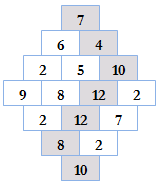F - Monkey Banana Problem
Time Limit:2000MS Memory Limit:32768KB 64bit IO Format:%lld & %lluDescription
You are in the world of mathematics to solve the great "Monkey Banana Problem". It states that, a monkey enters into a diamond shaped two dimensional array and can jump in any of the adjacent cells down from its current position (see figure). While moving from one cell to another, the monkey eats all the bananas kept in that cell. The monkey enters into the array from the upper part and goes out through the lower part. Find the maximum number of bananas the monkey can eat.

Input
Input starts with an integer T (≤ 50), denoting the number of test cases.
Every case starts with an integer N (1 ≤ N ≤ 100). It denotes that, there will be 2*N - 1 rows. The ith (1 ≤ i ≤ N) line of next N lines contains exactly i numbers. Then there will be N - 1 lines. The jth (1 ≤ j < N) line contains N - j integers. Each number is greater than zero and less than 215.
Output
For each case, print the case number and maximum number of bananas eaten by the monkey.
Sample Input
2
4
7
6 4
2 5 10
9 8 12 2
2 12 7
8 2
10
2
1
2 3
1
Sample Output
Case 1: 63
Case 2: 5
//题意第一行是 T 组测试数据,第二行 n 然后是 2*n-1 行的数据
从最上面那里出发,只能选做下走或者右下走,走到最下面那个位置,求路径上最大的和。
//很简单的 dp 注意一些特殊的情况就行
//72ms

1 #include <stdio.h>
2 #include <string.h>
3
4 int num[210][105];
5 int dp[210][105];
6
7 int max(int a ,int b)
8 {return a>b?a:b;}
9
10 int main()
11 {
12 int T,Case=0;
13 int i,j;
14 scanf("%d",&T);
15 while (T--)
16 {
17 int n;
18 scanf("%d",&n);
19 for (i=1;i<=2*n-1;i++)
20 {
21 if (i<=n)
22 for (j=1;j<=i;j++)
23 scanf("%d",&num[i][j]);
24 else
25 for (j=1;j<=2*n-i;j++)
26 scanf("%d",&num[i][j]);
27 }
28
29 memset(dp,0,sizeof(dp));
30 for (i=2*n-1;i>=1;i--)
31 {
32 if (i<n)
33 {
34 for (j=1;j<=i;j++)
35 dp[i][j]=max(dp[i+1][j],dp[i+1][j+1])+num[i][j];
36 }
37 else
38 {
39 for (j=1;j<=2*n-i;j++)
40 {
41 if (j==1)
42 dp[i][j]=dp[i+1][j]+num[i+1][j];
43 if (j!=1&&j==2*n-i)
44 dp[i][j]=dp[i+1][j-1]+num[i][j];
45
46 dp[i][j]=max(dp[i+1][j-1],dp[i+1][j])+num[i][j];
47 }
48 }
49 }
50 printf("Case %d: ",++Case);
51 printf("%d
",dp[1][1]);
52 }
53 return 0;
54 }
